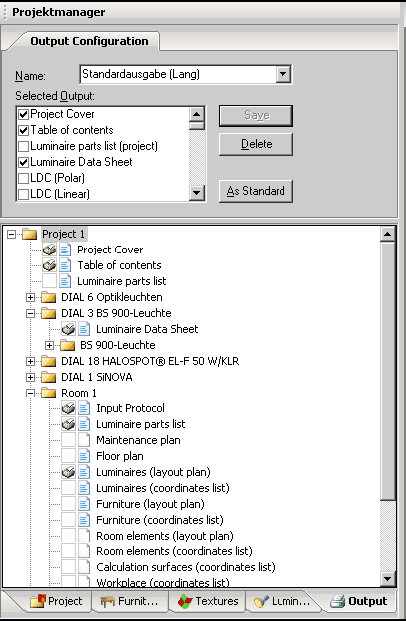- Главная
-
Учебник
- DIALux 4
- DIALux evo
- IES
- Форум
- Галерея
- Блоги
-
Скачать
- DIALux
- Базы
- Плагины
- 3D модели
- Текстуры
- Книги
-
Новости
Creating User-Defined Standard Output
11 сентября 2012 - АдминThe user can generate and save frequently-used combinations of output types in DIALux. To do this, a folder that contains output must be selected in the output tree.

Fig. 389 Creating standard outputs
Start on the highest hierarchy level, i.e. the project. Select the project in the output tree, in this case project 1. If you wish to use a preset standard, select it from the Name listbox. To generate a standard, check the output types which should be included in your standard. Please keep in mind that the list contains all output types, including those of lower hierarchy levels. For example, if you check the Isolines (E) output type in this hierarchy level, it is also checked in all lower hierarchical levels.
You can now select lower hierarchical levels and use a different output standard here. For example you can select Room 1 and select the Complete Documentation standard, which in this example describes a very extensive documentation. The other rooms are not affected by this change, as these still use the Short Documentation output standard which has previously been assigned to the project.
Thus you can influence the individual output subdirectories – thereby deviating from the global standard. Of course you additionally have the option of selecting the output types individually for every object in the output tree.
To use a user-defined output standard as default setting, select it from the Name listbox and click on the As Standard button. In the listbox the phrase Standard appears in brackets behind the corresponding name. To delete a user-defined standard, select it and click on Delete. After another standard has been selected from the listbox the one deleted previously is not available anymore.Рейтинг: 0 Голосов: 0 3090 просмотровКомментарии (0)Manual
